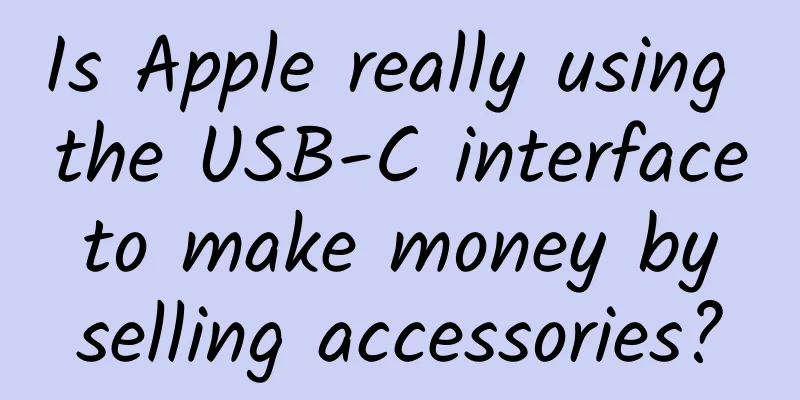Is Apple really using the USB-C interface to make money by selling accessories?

|
Apple's full deployment of USB-C interfaces on its MacBook products has displeased many users. Some complaints are normal, but some people think that Apple has changed the interface standard in this way, forcing users to spend money to buy a lot of adapters and cables, and Apple has made a lot of money in this way. However, foreign media Appleinsider pointed out that this is simply nonsense. The reasons are as follows: The USB-C standard was not developed by Apple. The USB-C connector was developed by the USB Implementers Forum, a non-profit organization that has been supervising the Universal Serial Bus since 1995. Although Apple is a member of USB-IF, there are no Apple people in the senior management of this organization. The directors of USB-IF mainly come from companies such as HP, Intel, Microsoft and chip manufacturer STMicroelectronics. USB-C is an open standard that can be used by any electronics manufacturer. In the next few years, we will see more and more new computer products adopting this standard. In the past, Apple has played a pivotal role in promoting the adoption of new connectors in computers. They worked with Intel to develop Thunderbolt, and Apple was also the first to use FireWire in its products, both of which are open standards. Some people have previously speculated that Apple played a major role in the development of USB-C, and some people also believe that Apple kept silent on the development of USB-C because they wanted the computer industry to use this interface in large quantities, and if it was an "Apple interface", it might affect the industry's adoption. In any case, USB-C was approved by an independent, non-profit board that has no interest in the success of Apple's Mac series. The reason why Apple or other computer manufacturers are pushing USB-C is simple. It is a thin, reversible, multi-functional all-in-one interface that can deliver power, data and video. Once the industry adopts USB-C in large quantities, the pain of switching from the USB-A standard will soon be forgotten. But before that, many early adopters will find that they have to rely on various adapters every day. Here we have to say that user complaints are largely misguided. USB-C doesn't bring profit to AppleApple does have a lot of USB-C and adapters for sale, and they're not cheap. Apple's accessories have always been more expensive than other manufacturers', and the same is true for Apple products. But because USB-C is an open standard, there are many third-party manufacturers' products on the market, and the price is much cheaper than Apple's. If Apple really only wants users to buy accessories that they produce or license, then they should design a new interface standard to compete with USB-C instead of using this open standard. If the MacBook Pro also uses the Lightning interface, it would be reasonable to say that Apple sells accessories to make money. Unfortunately, the MacBook Pro does not use Lightning. However, various user complaints later forced Apple to lower the price of USB-C and Thunderbolt 3 accessories, and they recently extended the promotion until the end of March 2017. Many people think that Apple sells accessories to make money, which is really strange. Not to mention that Apple has such a small share of the entire PC market. Perhaps the power adapter (29 watts) of the 12-inch MacBook can prove that Apple does not use USB-C to sell accessories. Users can buy this adapter through Apple for $49 separately. If you want to use Apple's USB-C charging cable, it costs $19, which brings the total to $68. In contrast, the MagSafe 2 power adapter (45 watts) for the MacBook Air costs $79. And the MagSafe cable is fixed to the adapter. If the cable breaks, you have to spend $79 to replace the whole thing. The adapter and cable of the new MacBook are detachable. If the cable breaks, you only need to buy a new cable for $19 instead of replacing the adapter. If you buy a third-party cable, the price is even lower. In other words, after using USB-C, it is easier and cheaper to replace the adapter. iPhone does not use USB-C Here we have to talk about another user dissatisfaction issue. To connect the iPhone to the new MacBook Pro, users either need a USB-C to USB-A adapter or a Lightning to USB-C cable, both of which are sold separately. As for why Apple didn't include an extra Lightning to USB-C cable in the iPhone 7 box, let's look at a set of data. Apple's best Mac sales were in September 2015, with sales of 5.7 million. In comparison, iPhone sales this holiday season were about 80 million, which means that far more people bought iPhones than Macs. Although it is painful to switch to USB-C on Macs, this transition is easier to complete because Mac users are much smaller than iPhones. If Apple included a Lightning to USB-C data cable in the iPhone box, users would really go crazy. Because this may be incompatible with the accessories they are currently using, such as computers and car adapters. After all, many accessories are still full-size USB interfaces. In this case, I am afraid that the situation will really get out of control. It is also for this reason that Apple will not easily use the USB-C interface on the iPhone or iPad-the entire ecosystem is built around iOS devices. Lightning may become the last input interface standard used on Apple iOS devices. In the future, Apple will gradually transition to wireless connection and wireless charging functions. Before that, Apple will not change the interface standard again. In 2012, with the release of iPhone 5, Apple changed the device's interface from 30-pin interface to Lightning interface, and users were dissatisfied for several years. In 2015, on The Late Show, Stephen Colbert, the host of the popular political satire program, was still teasing Apple about this matter. As a winner of Toutiao's Qingyun Plan and Baijiahao's Bai+ Plan, the 2019 Baidu Digital Author of the Year, the Baijiahao's Most Popular Author in the Technology Field, the 2019 Sogou Technology and Culture Author, and the 2021 Baijiahao Quarterly Influential Creator, he has won many awards, including the 2013 Sohu Best Industry Media Person, the 2015 China New Media Entrepreneurship Competition Beijing Third Place, the 2015 Guangmang Experience Award, the 2015 China New Media Entrepreneurship Competition Finals Third Place, and the 2018 Baidu Dynamic Annual Powerful Celebrity. |
<<: Ten old iPhones were put into water for three minutes and all died
>>: Google Pixel encounters screen freeze: Android flagship becomes a rip-off
Recommend
【APP Promotion Tips】Thoughts on Online Promotion
introduction: When I was setting the topic, I wan...
Zhihu account anti-ban rules and product promotion guidelines!
1. My experience of selling products on Zhihu, fr...
B2B Marketing Channel Promotion——Baidu SEM
There are many types of B2B marketing, but online...
Foshan WeChat used car mini program function, how much does it cost to develop a used car transaction mini program?
With the rise of "new energy" vehicles, ...
Pet mind reading: Solve your dog raising troubles
Course Catalog: R-65 It’s not difficult to become...
This is the secret of astronauts losing weight丨Tutu Science Fiction
Vocabulary weight scale rocket Gravitational acce...
Qidong SEO training: If you want to do online promotion, website structure is very important
With the development of the Internet era, everyon...
Is heat stroke the same as heat stroke? How to provide emergency treatment when you find heat stroke? See here!
Do you really understand heat stroke ? Rumor 1: H...
Is eating late night snacks addictive? How to eat to satisfy your cravings and stay healthy
Beer, kebabs, crayfish... Does it sound like you’...
CIC China Insights Consulting: 2017 China Culture and Entertainment Industry Blue Book
The latest blue book from CIC China Insights Cons...
Revealing the alternative method of using Apple loopholes for promotion
Have you ever been annoyed by those annoying bann...
"Transparent Earth" black technology: Using seismic waves to perform CT scans on the Earth
Major events on Earth are often related to its in...
Trump wants to cancel subsidies for electric vehicles. Why did Musk, who made 4.6 billion from it, say he was willing?
Just like sodium meets water, when Musk meets Tru...
iOS 14.5 RC version update: Added unlocking with mask, supports the latest AirTag
After Apple’s 2021 Spring Conference a few days a...
My friends, these "dates" that are bigger than eggs are in season and are really delicious!
Have you ever eaten apple dates? They are emerald...









